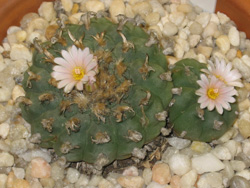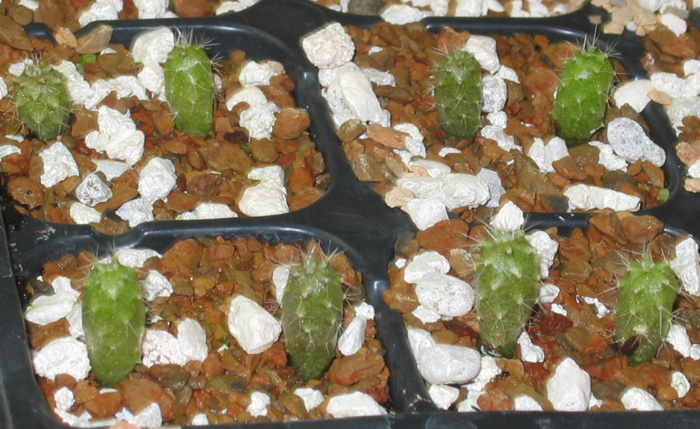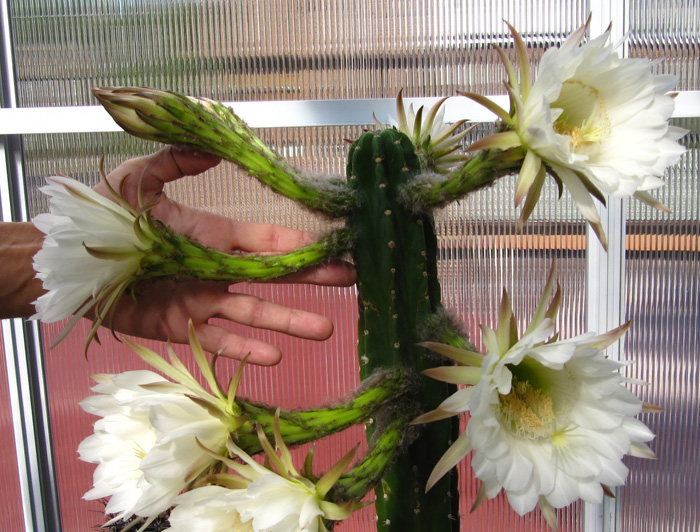
MagiCactus.com
The
new home of Lophophora Williamsii
and its closest friends
![]()
Trichocereus : San Pedro Cactus or Blue Torch
Trichocereus Pachanoi, Trichocereus Peruvianus, & Trichocereus Bridgesii
Above: Trichocereus pachanoi, Nocturnal Bloomers
The name San Pedro is considered a synonym for any of the psychoactive cacti within the genus Trichocereus. Although there are primarily three species of cacti within the genus well known for their ceremonial use by native tribes of North America, Trichocereus Pachanoi, Trichocereus Peruvianus also known as the Peruvian Torch Cactus or Blue Torch Cactus, and Tricocereus bridgesii, there are actually ten known species within the genus that are known to carry mescaline as a primary alkaloid. The species known to contain mescaline as their primary alkaloids are Trichocereus bridgesii, Trichocereus cuzcoensis, Trichocereus fulvinanus, Trichocereus macrogonus, Trichocereus pachanoi, Trichocereus peruvianus, Trichocereus taquimbalensis, Trichocereus tersheckii, Trichocereus validus, and Trichocereus werdermannius all of which have been used by indigenous tribes for over three thousand years.
The genus Trichocereus, consists of about thirty different columnar type plants that have been clumped into the genus Echinopsis in 1974, creating what is now one of the largest collection of species yet clumped together. Personally I don't care for this clumping of cacti because of the confusion associated with a combination of small barrel type cacti that flower during the day and those that are columnar and flower at night. For this reason here on my website I will keep the two genus' separate.
Although San Pedro has been the term used for all the psychoactive members of the genus Trichocereus, the title of San Pedro is actually a synonym for the species Trichocereus pachanoi consumed by the Native Indians of Peru. The term Blue Torch more specifically refers to that of Trichocereus peruvianus.
As far as alkaloids go, mescaline is the primary one of interest to most people. Trichocereus pachanoi is said to have about a third of the amount of mescaline when compared gram per gram to that of Lophophora Williamsii. On the other hand it is also said that Trichocereus peruvianus has an equal amount of mescaline gram per gram to that of Lophophora Williamsii making it one of the most sought after members of the species. Trichocereus bridgesii is said to be about equal to that of the pachanoi variation. Having interviewed many who have consumed these plants, I have learned that all members of the genus containing mescaline seem to offer the same experience, and are considered to have the same content, yet there are some people that say different and swear by one species over the other. Published research papers are somewhat inconclusive in that they all have different results for percentages of alkaloid contents, with one saying that a species has much more than others. Who knows what scientist and botanists do to come up with their numbers. As far as I am concerned much of what you get is dependent on how the plants are grown and cared for.

Above: Trichocereus peruvianus seedlings at two months
Growing Trichocereus Species: Trichocereus peruvianus, pachanoi and bridgesii are some of the easiest cacti to grow because they can take a lot of abuse, are generally quite cold hardy down to about minus ten degrees. They can take all the rain a Canadian summer can offer and seem to be quite resistant to most bug infestations in turn putting up well with most mistakes that growers make with cacti. Trichocereus seedlings also grow very fast as can be seen by the few in the image below reaching ten to sixteen inches in only three years.
The first question most often asked is about mix. I tend to use the same mix for all my cacti which can be learned on my propagation page but this genus of plants seems to be able to grow in almost anything so feel free to experiment. My only advice is that you make sure that at least fifty percent of the material used is for drainage otherwise when the plant starts slowing down and getting ready for winter you can lose it to rot like any other cactus.
When growing any of the Trichocereus columnar species a very important step that is missed by most growers is the chopping of the stem. At about the ten month point of growth most seedlings will reach six inches in height or more. At this point a plant can actually be chopped and used as grafting stock but due to the young age of roots grafts will not last long. It is far better to wait for the plants to reach two years of age or better. Now back to our important tip for growing these amazing plants. Between the ages of six to ten months seedlings will be six to eight inches tall or better. At this point the stalks are still quite thin allowing the plant to fall over most especially once thirsty. The best thing to do at this point is actually chop the plant down at a point where the stem seems to be thickening. This would be anywhere from one inch to three inches off the ground surface. At this point allow the cut to dry and heal, and then replant it. The seedling will grow much thicker and stronger if this step is performed. For those who prefer to allow the plant to grow naturally, they will end up with a plant that falls over and eventually begins shooting pups up which will take a very long time to get a plant that stands on its own.
By its second year, Trichocereus peruvianus as well as pachanoi and bridgesii can be potted up into six or eight inch pots, and for best growth they will need potting up practically each year. Pups will even begin emerging from most three year old plants as can be seen on the plant to the left down below.
Never be afraid to chop the top of these plants because they seem to almost need it. As soon as a cut heals, off they go growing more branches. With each successive year one can notice these plants growing at a compounded rate in fact meaning that the bigger they grow the more they will grow each year as a result. Those who consume these plants state that ten to fifteen inches of growth each year is not uncommon which in turn offers the potential for at least two ceremonial adventures while having the plant still working towards your next adventure. Another very important reason for chopping the tops of these plants for repotting is the fact that all three of these species will grow to between twenty and thirty feet tall if not attended to. This is probably far too big for most collectors that keep plants indoors or in a greenhouse.
Above: Trichocereus peruvianus three year old seedlings
Difference between the three Trichocereus Species
Trichocereus pachanoi (Echinopsis pachanoi)(syn. San Pedro cactus), seems to have the longest history of use and is possibly the most popular of the species. In my experience it also seems to be the easiest to handle since it has very small spines, making it a very good choice as a grafting stock. Alkaloid wise it is said to have about a third of the primary alkaloid mescaline as does the famed Lophophora Williamsii. None the less this species of plant grows at an astounding rate offering much more plant body than any Lophophora so the playing field levels out. Trichocereus pachanoi also seems to grow thicker bodied than Trichocereus bridgesii. Both these factors possibly make it the plant of choice for ceremonial purposes. By the way, these plants shoot some of the most incredible sweet smelling flowers that are about the size of a grown man's hand. This can be seen in the picture here below taken in the summer of 2010. Plan to stay up late once the flower bud is ready to open, these plants are nocturnal bloomers and won't begin to open until the sun is long gone and the moon is rising. If you are lucky the blooms will last two days, maybe even three. Distribution of this species is Ecuador and Peru.
Trichocereus peruvianus (Echinopsis peruvianus)(syn. Blue Torch, San Pedro Macho), on the other hand grows some of the most incredible spines for cacti enthusiasts to admire and actually seem to grow thicker offering more body weight when compared to either the pachanoi or bridgesii variations. The needles of this cactus commonly grow to over ten centimetres long so great care is needed when replanting or cutting. It seems the latest rage in mescaline bearing plants is the alkaloid content and this species is said to offer the greatest bang for the buck with equal percentages of mescaline gram per gram to that of Lophophora Williamsii. Tests unfortunately are inconclusive so experiments to justify such findings is up to the user. Distribution of this species is Peru.
Trichocereus bridgesii (Echinopsis lagenisformis), seems to be somewhat in the middle with average sized spines and overall good stem growth. Those that have consumed this plant seem to swear that the difference in alkaloids allows this species to offer a more profound experience than the others, but that is only information I have read, so if you choose you will have to find out for yourself. Distribution of this species is La Paz, Bolivia.

Above: Trichocereus pachanoi flower in hand
Consumption: Honestly speaking I have never consumed any of these plants so the information that follows comes from speaking to members of the Native American Church, researching books and the world wide web.
Members of the genus Trichocereus have been consumed by indigenous tribes of North and South America for over three thousand years. Mescaline is most highly concentrated on the outer layer against the skin which is often peeled and dried in order to be ground into a fine powder or boiled into a tea of sorts. This is done by boiling slices of the stem for a number of hours before it is drunk.
As far as it goes a dosage consists of between 350 and 500mg, which should be taken in two doses about a half hour apart. This can be achieved from a section about ten inches long and three inches wide. There is such a variance in amount because there is a wide range of tolerances amongst people in that some will have an experience from three to four peyote buttons while others might consume a dozen or two for a spiritual experience.
When harvesting, it is best to chop a four to ten inch piece from the top for replanting and then making another cut about ten inches long for consumption. The lowest and final cut should be made at a ten to twenty degree angle to allow for water drainage while the cut heals. Cutting at an angle as should be done with Lophophora will prevent pooling of water which could grow mould and eventually kill the plant. Once the top section dries and heals it can them be placed in a pot with your favourite cactus mix and allowed to grow, just as the original plant will begin shooting new branches once its cut heals.
Once you have your section cut, it is time to trim off the spines. Be very careful with this unless you don't mind getting pricked. Then sections can be cut and either chewed raw or boiled down for a number of hours creating a bitter tea that can be drunk. Although the skin is not edible the meat of the cactus closest to it is said to be the most potent so people will tend to slice the skin off and scrape the meat off it with their teeth before proceeding to eat the rest of the cactus like a corn husk leaving the centre core to waste since it is often hardened like a corn husks core. Effects are often felt within thirty to forty minutes of ingestion.
Above: Trichocereus pachanoi flower
email: dr_frank @ magicactus.com
Mailing address:
Frank Valente
MagiCactus.com
56 Dewhurst Blvd.
Toronto, Ontario
M4J 3J3
© 2008, Frank Valente